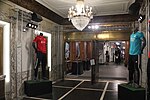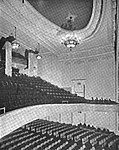TSX Broadway

TSX Broadway is an under-construction 46-story mixed-use building on Times Square, at the southeastern corner of Broadway and 47th Street, in Midtown Manhattan, New York City. Developed by L&L Holding, the building will include a 669-room hotel, multi-story retail space, and an existing Broadway theatre called the Palace Theatre. The TSX Broadway development involves the reconstruction of a DoubleTree hotel that was completed in 1991, as well as the lifting of the Palace Theatre at the former hotel's base. The framework of the hotel's first 16 stories remains largely intact, but the upper floors have been demolished. Work on the new structure began in 2019, and the building is planned to be completed in 2023.
Excerpt from the Wikipedia article TSX Broadway (License: CC BY-SA 3.0, Authors, Images).TSX Broadway
West 47th Street, New York Manhattan
Geographical coordinates (GPS) Address Nearby Places Show on map
Geographical coordinates (GPS)
| Latitude | Longitude |
|---|---|
| N 40.759 ° | E -73.984523 ° |
Address
West 47th Street 160
10036 New York, Manhattan
New York, United States
Open on Google Maps









